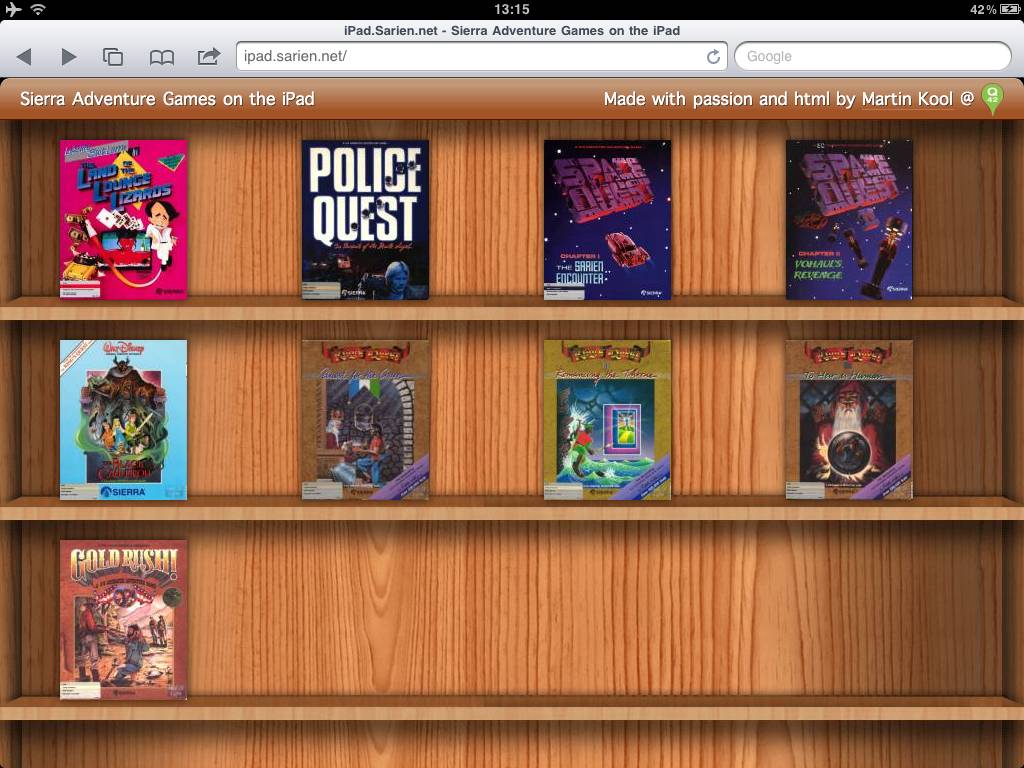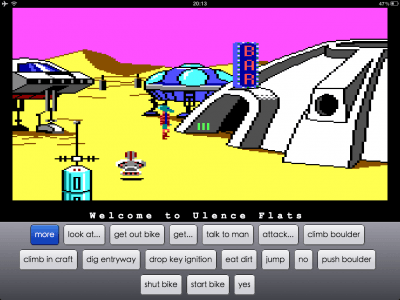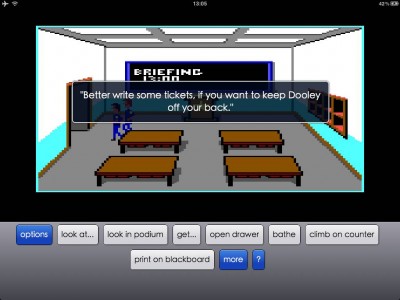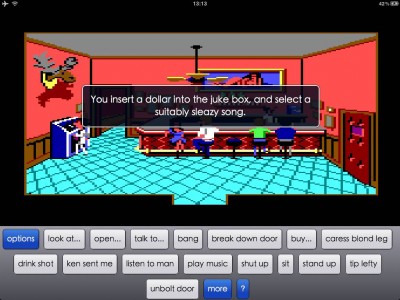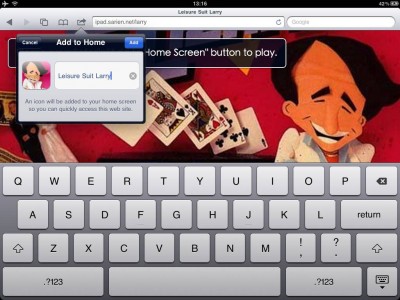In addition to reducing productivity at work, retro game developer Q42 looks to change the quality of games we play with browsers using HTML5 and their site Sarien.net. Starting out as a simple retro chat environment then evolving into a full-scale Ipad game using HTML5 without the need for the App Store, surprisingly this little start up didn’t concern Apple as much as it did Activision. This was due to the fact that the games being ported into Browser Based experiences were Sierra games, which Activision owns the license to. The Co-Owner of Q42 Martin Kool had been developing the technology since 2003 and was only recently brought into the limelight due to the success of their Ipad friendly games; they effectively showed what the Ipad can do without the App Store. Martin recently agreed to do an interview with us on all of these topics and more, this is how it went!
1. Welcome Martin, thanks for talking to Capsule Computers; firstly I’d like to ask are you much of a current generation Gamer? Or do you prefer to keep it retro?
MK: To be honest, it’s not a specific era of gaming that I prefer. I’m just a sucker for gameplay value and originality. Some of my favourite titles are all over the map in terms of age and genre:
Beyond Good & Evil
Sensible Soccer
Day of the Tentacle
Tie Fighter D/Generation
Fallout (the original)
Fable (all three)
Red Dead Redemption
Quest for Glory 1 (the remake)
Diablo
Space Quest 3
Half-Life
Galaxy on Fire 2
2. Tell me a little bit about Sarien.net, what it does and why you created it.
MK: Sarien.Net is a website that offers the first series of Sierra adventure games such as King’s Quest and Police Quest, playable in a browser, and while you’re playing you can see other people playing and chat with them. It’s a mix between retro adventure gaming and a social experiment. The first adventure game truly designed for multi-player still hasn’t been invented yet (Sierra tried with TSN and failed). When my Sierra-inspired chat-environment Good Old Adventures made people request the original gameplay, I regarded it as a natural next step for me to build the actual game interpreter but keep the multiplayer aspect. So even though there’s no actual multiplayer gameplay, it’s been great to see so many people having fun out there. To me, the experiment was a huge success, and I think the “Sarien treatment” would work well for a whole lot of other games, old and new. The adventure game genre is back in the spotlight these days. That wasn’t the case when I started working on Sarien and I believed that these games deserved to be played again, only this time in a more contemporary format. That’s what Sarien offers and it turned out to be a technical showcase once iPad support was added
3. What was the first game you ported into Sarien.net and what sort of technical difficulties did you have to get it working?
MK: A year or two before I began building the interpreter I had already created a few stand-alone tools for extracting and converting in-game pictures and objects to images, HTML, CSS and Javascript. This test environment had an avatar walking behind and in front of objects and path-detection was somewhat in place. My next step was converting the original logic scripts (containing all the game triggers and making stuff happen) to something that was javascript-parseable. This was one of the challenging parts, because these games were written in a non-object-oriented language, and used GOTO statements to arbitrarily jump back and forth between the game logic. I de-compiled all nested statements to a flat-lined heap of calls, and surrounded it with javascript’s switch/case construction in an infinite loop. This allowed me to keep track of a virtual line number while code was being executed, and then loop back into the switch statement that would delegate the code to the next lines, wherever they may be.
It turned out to be a working replacement of GOTO’s without using a stack of function calls, thus giving me control over the engine (and with multi-player) which resulted in an interpreter stub that ran without errors. It did nothing at all, it just didn’t fail. So here I had an interpreter that was doing nothing at all except being an endless looping game cycle, and then I had my separate test environment with an avatar walking around. Now where to start? This was the second challenge, as I had to merge all these things together and build the actual interpreter logic as well as all AGI commands required. I took a scene from one of my favourite games, the elevator screen at the start of Space Quest 1, and focused on making that scene work. So I started implementing the logics that would draw a room when the code required it and draw the avatar when and how the original game developers chose to do it. Then I made the alarms flash, made some event-triggering code work so that the elevators would open and close once you got near it, etc. This approach had me implementing code and testing it by walking around. Each day, more stuff started working.
4. Gaming on browsers has been around for quite awhile, but more casual games than anything else, especially with the rise of Facebook gaming. The games you’ve done could be considered to cater for the hardcore minded or nostalgia induced gamers. What inspired you to bring full-blown retro gaming to a browser based format?
MK: I used to do a lot of back-end programming, but 11 years ago I fell in love the web. Q42 showed me their HTML editor that they made in javascript (it was wysiwyg, which was quite impressive in 2000) and I was hooked. We teamed up, and within a few months we released an online playground called Quek that offered a virtual avatar on top of an existing site and had you chatting with others. My love for web technology only went on from there, as did the format itself (web 2.0, ajax, HTML5). I think my passion for the web, technology and games was a sweet combination. Never did I set out to build a full blown game, but neither did I see any limitations that prevented anyone from doing so. Sure, the web offers a lot of constraints, but that’s what drives creativity. Twitter didn’t invent the @ sign, hashtag or retweets. People worked with constraints and the format adapted.
5. How does the multi-player work on Sarien.net ?
MK: It’s a very simple approach, and there are quite a few other ways I’d go about implementing it now in hindsight. It’s basically an asynchronous pulling mechanism, each player has an interval at which it sends recent changes to the server. These changes contain information such as “walked to x,y”, “said this or that”, etc. Each time the player sends this information; it receives the changes that were made by other players in the same room, and processes it on the client. This means that the game engine will make other players walk around, show speech balloons, and if there’s a discrepancy in where they should walk to and where the browser allows them to walk, I fall-back to fading a player out and in again. The server is also very simple. All it does is keep track of rooms, players, player actions and some bookkeeping with date/time stamps. All Sarien’s conversion tools are open source, including the browser-based game interpreter as well as Q42’s multiplayer engine.
6. How many games are currently running on Sarien.net? Could you list them all?
MK: Right now there’s Space Quest, Police Quest, King’s Quest and only the first episode of each series. Then there’s The Black Cauldron and Gold Rush. As I write this there is no Leisure Suit Larry as I just received my second Cease and Desist letter so I removed it, though chances are it’ll return with official authorization (similar to what Activision did)
7. You’ve mentioned that you were originally sceptical of the Ipad, until you started working with it. Would you consider doing anything for Android tablets as more come out this year?
MK: I don’t know. Sarien isn’t allowed to host iPads specific games anymore, and I’m not into Android tablets that much. Not from a fanboy perspective (I don’t consider myself one, even though I work on a Macbook Air and carry an iPad/iPhone) but Android phones/tablets just aren’t my thing. I got a plastic Android phone at Google IO one time and gave it away. Didn’t like it. Perhaps I’m an Apple fanboy after all? I am intrigued by Android honeycomb though, but that’s probably the geek in me that wants to take such a tablet out for a spin.
8. 2011 in the tech world is supposedly going to be the year of the Tablet, which means more and more apps/games will be coming out. Do you see browser based games becoming a bigger competitor, or a unique alternative to the App store?’
MK: I think that Apple’s recent move to cash in on subscription-based publishing apps will have developers seek other possibilities, and HTML5 is a viable option for such apps. Games on the other hand, that’s a different story. I think a masterpiece such as Braid would play well if ported to mobile safari because it could use a smart combination of canvas and sprited images. Technology-wise, browser-based 2D games on tablets are a possibility and could par with some native games. However, for browser-based games to succeed, we need more than just the technology to make it happen. Apple proved that a centralized store makes all the difference, and payments should be a simple and hassle-free process. Buying a game on the iPad requires a few taps and one password. You’d need to make things mainstream with development tools aswell.
Even though the web is moving forward I think that native technology is moving forward in a much faster pace (as it comes without the sluggish W3C/browser-vendor process of adapting new features). Although I love the open concept of the web for gaming, I don’t think it will ever surpass native gaming. And why should it? Native mobile technology and web technology are two separate worlds. Google is betting on both: on one hand they’ve got Android and its marketplace, on the other there’s Chrome OS, the Chrome browser (my personal favourite) and perhaps most important, the Chrome Web store includes easy payments with Google Checkout. In the end, I don’t think there will be one winner, just two alternatives.
9. Given the retro nature of the games you’ve successfully ported so far, just how complex can browser based games get right now? Are you limited or is something like 3D possible with HTML5?
MK: Theoretically speaking, if someone would port Grim Fandango to HTML5, javascript and canvas it should run fine on Chrome or Safari on a desktop machine. So a combination of 3D/2D, music and sound sure isn’t a thing of the future. I do however think that’s it not a matter of the technology being ready for it, but it’s the tools becoming mainstream. Current SDK’s, frameworks and IDE’s focus on what’s mainstream, and HTML5 isn’t that (for gaming). I’d love to see Unity compiled to HTML5 and canvas.
10. Do you think HTML5 will eventually overtake Flash? And if so, how long do you think it’ll take before that happens?
MK: Didn’t it already? I don’t know what statistics would mark this moment, but as far as I’m concerned, flash never lived. The only thing still holding it together are those shovelware flash games. Even for monolithic campaign websites you see people use HTML5 as the tools to do so are indeed emerging. I recently saw a few products that focus on interactive banner development using HTML5. Like I said earlier, you need both the technology and tools to be ready for it.
11. You’ve briefly mentioned on your site that there’s an exciting Q42 project, which involves newspaper publishers on the Ipad having the ability to cut out the middleman; any chance of giving us a hint of what that involves?
MK: *Smiles* No
12. Now that you’ve had some contact with a publisher (Activision), do you think you’ll develop any original IP’s in the future?
MK: Perhaps. But it’s not what I’m after. There are a few chapters I like to finish in terms of my involvement with Sierra games, and I would love to bring them natively to the iPad with a gameplay experience that I envision. If my pursuit succeeds, who knows what happens next? I’m not after doing any original IP development per se, its creativity and a unique proposition that I value. It helps that I’m perfectly happy with my life, both personal and professional, as I’m not after the big bucks. I look for opportunities, not business opportunities. This happens to clash in a healthy and often funny way with my awesome business partners from time to time.
What I like to do is build something special, something that I believe makes a difference, regardless if it’s a game, an app, a service or something carved out of wood. Sarien’s retro slash multi-player experience is just one such example. Also very special to me is Quplo, our tool for HTML prototyping that fills a gap in the development process right between design and development. I’m really glad it is already helpful to thousands of users, and we’ve been able to release quite some side products to the open source community along the way. For instance, Backfire – a tiny open source project that allows users to save changes made on a web-page with firebug – has recently been ported to Django. Those things mean a lot to me.
13. Who do you think is the coolest Sierra Character ever made and why?
MK: I’d have to say Larry. Actually he’s certainly not the coolest, but his character is portrayed very well, and his clumsy self-unawareness makes him a very charming guy. Al did a great job crafting him, and it’s a shame that the last two instalments (that were written and built without Al Lowe’s consent) screwed the franchise over. I mean, Leisure Suit Larry really nuked the fridge with Box Office Bust, naturally scoring as low as 20/100 on metacritic. If it were up to me, I’d build and release a native iPad version of the original Leisure Suit Larry, but include the GUI enhancements, unlockables and all the other stuff that I added to Sarien’s iPad version before it got a Cease and Desist letter… Twice.
14. Well Thanks for your time Martin and In-depth answers, hopefully the readers enjoyed it. One last question as I assume you’re a fan, what’s your favourite Sierra game?
MK: Quest for Glory 1, the remake
Martin Kool is a Stunt coordinator, co-owner of Q42 and Founder of Quplo. He Wrote Sarien.net and considers himself a Technologist, Geek and gamer.
You can follow him at http://twitter.com/mrtnkl


